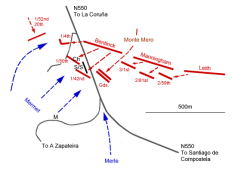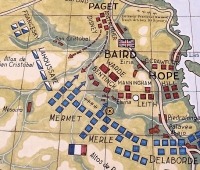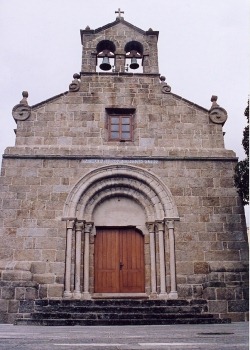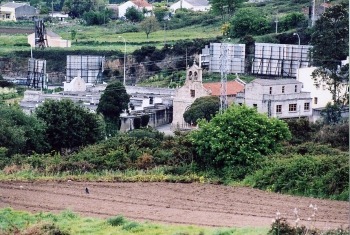
Before reaching La Coruña, Lt.-Gen. Sir John Moore, at the head of the retreating British army, was aware that his transport ships had not yet reached harbour, and that he would probably be compelled to fight a defensive action against the pursuing French army under Marshal Nicolas Soult before being able to embark. On the night of 11th/12th January 1809, the 1st, 2nd and 3rd British Divisions commanded by Baird, Hope and Fraser reached La Coruña, while the Reserve Division under Paget halted 11km outside town at El Burgo (O Burgo), buying valuable time by blowing the bridge over the Mero river. It was not until the 13th that the French found a way across the Mero at Celas, forcing Paget to fall back towards La Coruña. On the afternoon of the 14th, Moore's transports reached harbour and the evacuation of the British sick, wounded, cavalry and artillery began. Moore's chosen defensive position at La Coruña was to occupy the low ridge of Monte Mero with Hope's Division on the left, and Baird's Division on the right; Paget's Division was held in reserve behind the ridge. The position was not without its weaknesses: the lower, western end of the ridge above the village of Elviña was exposed to artillery fire from the higher ground to the south, and the whole position would be turned if Soult could force the 1,000m gap between Elviña and the heights of San Cristobal to the west. It was midday on the 16th before Soult had brought into position the force of more than 20,000 men that gave him the confidence to attack the 15,000-strong British army. Had Soult not attacked in the afternoon, it is likely that Moore would have been able to embark overnight. At around 1.30 or 2pm on the 16th, the British lines behind Elviña came under artillery fire as Soult commenced his attack: infantry advanced in column against the right flank of the British line on Monte Mero, while cavalry headed for the gap below the San Cristobal heights. Moore neutralized the threat posed by the cavalry by pushing forward Paget's Division into the gap. The outcome of the battle would depend on the fight for control of the slopes behind Elviña.
Bentinck's Brigade took the brunt of the first French assault as two brigades of Mermet's Division under Gaulois and Jardon drove the light company of the 1/50th out of Elviña before surging on up Monte Mero. The French columns were brought to a halt in the face of withering fire from the 1/50th and 1/42nd, before falling back as the two British battalions advanced. The 1/50th swept through Elviña before being thrown back in turn as Mermet committed his reserves to the battle. Meanwhile, the third of Bentinck's battalions, the 1/4th, had deployed to counter an outflanking movement being made by the third brigade of Mermet's Division under Lefebvre. To this end, the 1/4th was later supported by the 1/52nd and 20th from Paget's Division which successfully broke the French brigade.
As Mermet's brigades renewed their assault on Monte Mero, Moore brought forward two battalions of Guards to strengthen the line. Shortly afterwards, Moore was mortally wounded when struck by a cannon-ball, and command of the army passed to Lt.-Gen. Sir John Hope. Reynaud's Brigade from Merle's Division now joined the battle by advancing against Bentinck's left, but was itself taken in the flank by the 3/1st and 2/81st of Manningham's Brigade. After a prolonged engagement, the French finally fell back from the slopes. To the east of Elviña, the French had made little effort to attack the British positions higher up on the ridge. As darkness began to envelop the battlefield, the firing died down along the whole line. The British withdrew from Monte Mero on the night of the battle, and completed their evacuation by sea on the 18th. Hope reported British losses in the battle as being between 700 and 800; French losses have been estimated by Oman at 1,500. Although the battlefield has been partially obliterated, particularly by cutting into Monte Mero to allow the N550 to pass through, there is still much to see. The village of Elviña is easier to find on leaving La Coruña, so take time first to visit the tomb of Sir John Moore inside the Jardines de San Carlos located in the old town (Ciudad Vieja). To find the battlefield, leave the city on the N550 (Avenida del Alcade Alfonso Molina). Shortly after the Carrefour hypermarket, there is an exit for the Campus Universitario de Elviña. Take the exit, and turn immediately left to reach the village. Alternatively, pull into the space in front of the Repsol service station a short distance further along the N550 and walk down to the church and village. The slopes up to the French positions remain largely clear of modern development. Returning to the N550, take the next exit signposted to A Zapateira. A short distance uphill, there is a monument to Sir John Moore and a fine tiled map of the battle to the right of the road. The orientation of the map is slightly misleading as it suggests Elviña to be in the vicinity of the hypermarket whereas in reality it lies well to the right from this viewpoint. "A History of the Peninsular War, Volume I" by Sir Charles Oman, published by Greenhill Books 1995, ISBN 1853672149. Map of the Battle of La Coruña courtesy of The Napoleon Series. © Andrew C Jackson 2006
|



